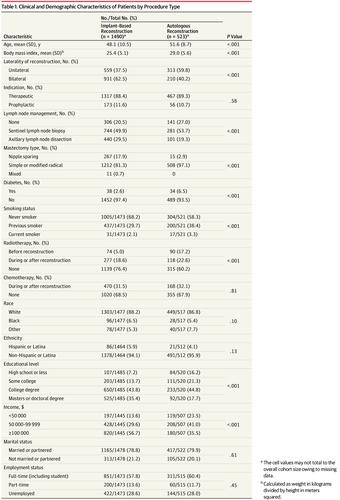JAMA Surgery ( IF 15.7 ) Pub Date : 2018-10-01 , DOI: 10.1001/jamasurg.2018.1677 Katherine B Santosa 1 , Ji Qi 1 , Hyungjin M Kim 2, 3 , Jennifer B Hamill 1 , Edwin G Wilkins 1 , Andrea L Pusic 4, 5

|
Importance Previous outcome studies comparing implant and autologous breast reconstruction techniques have been limited by short-term follow-up, single-center design, and a lack of rigorous patient-reported outcome data. An understanding of the expected satisfaction and breast-related quality of life associated with each type of procedure is central to the decision-making process.
Objective To determine outcomes reported by patients undergoing postmastectomy breast reconstruction using implant or autologous techniques 2 years after surgery.
Design, Setting, and Participants Patients were recruited from 11 centers (57 plastic surgeons) across North America for the Mastectomy Reconstruction Outcomes Consortium study, a prospective, multicenter trial, from February 1, 2012, to July 31, 2015. Women undergoing immediate breast reconstruction using implant or autologous tissue reconstruction after mastectomy for cancer treatment or prophylaxis were eligible. Overall, 2013 women (1490 implant and 523 autologous tissue reconstruction) met the inclusion criteria. All patients included in this analysis had 2 years of follow-up.
Exposures Procedure type (ie, implant vs autologous tissue reconstruction).
Main Outcomes and Measures The primary outcomes of interest were scores on the BREAST-Q, a validated, condition-specific, patient-reported outcome instrument, which were collected prior to and at 2 years after surgery. The following 4 domains of the BREAST-Q reconstruction module were evaluated: satisfaction with breasts, psychosocial well-being, physical well-being, and sexual well-being. Responses from each scale were summed and transformed on a 0 to 100 scale, with higher numbers representing greater satisfaction or quality of life.
Results Of the 2013 women in the study (mean [SD] age, 48.1 [10.5] years for the group that underwent implant-based reconstruction and 51.6 [8.7] years for the group that underwent autologous reconstruction), 1217 (60.5%) completed questionnaires at 2 years after reconstruction. After controlling for baseline patient characteristics, patients who underwent autologous reconstruction had greater satisfaction with their breasts (difference, 7.94; 95% CI, 5.68-10.20; P < .001), psychosocial well-being (difference, 3.27; 95% CI, 1.25-5.29; P = .002), and sexual well-being (difference, 5.53; 95% CI, 2.95-8.11; P < .001) at 2 years compared with patients who underwent implant reconstruction.
Conclusions and Relevance At 2 years, patients who underwent autologous reconstruction were more satisfied with their breasts and had greater psychosocial well-being and sexual well-being than did those who underwent implant reconstruction. These findings can inform patients and their clinicians about expected satisfaction and quality of life outcomes of autologous vs implant-based procedures and further support the adoption of shared decision making in clinical practice.
中文翻译:

乳房切除术后乳房重建的长期患者报告结果。
重要性 以前的结果研究比较植入物和自体乳房再造技术受到短期随访,单中心设计和缺乏严格的患者报告结果数据的限制。与每种手术类型相关的预期满意度和与乳房相关的生活质量的理解对于决策过程至关重要。
目的 确定术后2年使用植入物或自体技术进行乳房切除术后乳房重建的患者报告的结果。
设计,背景和参与者 从2012年2月1日至2015年7月31日在北美进行的一项前瞻性,多中心试验,从北美的11个中心(57位整形外科医生)中招募了患者,作为一项前瞻性,多中心试验。乳房切除术后使用植入物或自体组织重建进行癌症治疗或预防是合格的。总体而言,2013年女性(1490例植入物和523例自体组织重建术)符合纳入标准。该分析中包括的所有患者均接受了2年的随访。
暴露 程序类型(即植入物与自体组织重建)。
主要结果和测量 感兴趣的主要结果是BREAST-Q的分数,BREAST-Q是一种经过验证的,针对特定病情,由患者报告的结果工具,在手术前和手术后2年进行收集。评估了BREAST-Q重建模块的以下4个领域:乳房满意度,心理社会福祉,身体福祉和性福祉。汇总每个量表的响应并在0到100量表之间进行转换,数字越高代表满意度或生活质量越高。
结果 在2013年的研究女性中(平均[SD]年龄,进行了基于种植体的重建组的平均年龄为48.1 [10.5]岁,进行了自体重建的组的平均年龄为51.6 [8.7]岁),完成了1217例(60.5%)重建后2年进行问卷调查。在控制了基线患者的特征后,进行自体重建的患者对乳房的满意度更高(差异为7.94; 95%CI为5.68-10.20;P <.001),社会心理健康状况(差异为3.27; 95%CI: 与接受植入物重建的患者相比,在2年时的 性健康状况(差异为1.25-5.29;P = 0.002)和差异(差异为5.53; 95%CI为2.95-8.11;P <.001)。
结论与相关性 2年后,自体重建的患者比植入物重建的患者对乳房的满意度更高,并具有更大的社会心理健康和性健康。这些发现可以使患者及其临床医生了解自体手术与基于植入物的手术的预期满意度和生活质量,并进一步支持在临床实践中采用共同决策。











































 京公网安备 11010802027423号
京公网安备 11010802027423号